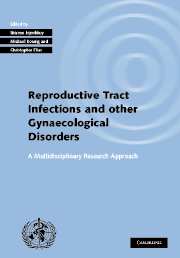 Investigating Reproductive Tract Infections and Other Gynaecological Disorders
Investigating Reproductive Tract Infections and Other Gynaecological Disorders Book contents
- Frontmatter
- Contents
- List of contributors
- Foreword by Paul F.A. Van Look
- Acknowledgements
- 1 Introduction and overview
- 2 Defining reproductive tract infections and other gynaecological morbidities
- 3 The social context of gynaecological morbidity: correlates, consequences and health seeking behaviour
- 4 Reproductive health: men's roles and men's rights
- 5 Study design for the measurement of gynaecological morbidity
- 6 Alternatives to community-based study designs for research on women's gynaecological morbidity
- 7 Community interaction in studies of gynaecological morbidity: experiences in Egypt, India and Uganda
- 8 Definitions of clinically diagnosed gynaecological morbidity resulting from reproductive tract infection
- 9 Laboratory tests for the detection of reproductive tract infections
- 10 Laboratory methods for the diagnosis of reproductive tract infections and selected conditions in population-based studies
- 11 The value of the imperfect: the contribution of interview surveys to the study of gynaecological ill health
- 12 Qualitative methods in gynaecological morbidity research
- 13 Integrating qualitative and quantitative methods in research on reproductive health
- 14 Interpreting results from different sources of data
- 15 Turning research into action
- Appendix A Notes on contributors
- Index
5 - Study design for the measurement of gynaecological morbidity
Published online by Cambridge University Press: 07 December 2009
- Frontmatter
- Contents
- List of contributors
- Foreword by Paul F.A. Van Look
- Acknowledgements
- 1 Introduction and overview
- 2 Defining reproductive tract infections and other gynaecological morbidities
- 3 The social context of gynaecological morbidity: correlates, consequences and health seeking behaviour
- 4 Reproductive health: men's roles and men's rights
- 5 Study design for the measurement of gynaecological morbidity
- 6 Alternatives to community-based study designs for research on women's gynaecological morbidity
- 7 Community interaction in studies of gynaecological morbidity: experiences in Egypt, India and Uganda
- 8 Definitions of clinically diagnosed gynaecological morbidity resulting from reproductive tract infection
- 9 Laboratory tests for the detection of reproductive tract infections
- 10 Laboratory methods for the diagnosis of reproductive tract infections and selected conditions in population-based studies
- 11 The value of the imperfect: the contribution of interview surveys to the study of gynaecological ill health
- 12 Qualitative methods in gynaecological morbidity research
- 13 Integrating qualitative and quantitative methods in research on reproductive health
- 14 Interpreting results from different sources of data
- 15 Turning research into action
- Appendix A Notes on contributors
- Index
Summary
This chapter addresses design issues in the measurement of gynaecological morbidity. Recognizing that gynaecological morbidity is a complex phenomenon, the possible study designs are reviewed and their shortcomings and strengths are highlighted. Finally, I shall focus on community-based studies as they provide a holistic view of gynaecological morbidity from various perspectives.
In considering designs for the measurement of gynaecological morbidity, three questions need to be asked: Why are we concerned with measuring gynaecological morbidity (or, what is our aim)?; Who is our target population?; What concepts are we trying to measure?
The aims of measuring gynaecological morbidity are, in my view, to establish the prevalence of morbidity conditions, and to understand perspectives, behaviours and experiences, as well as determinants, for the purpose of guiding policies and programmes aimed at reducing reproductive morbidity. Interventions can then be designed, on the basis of such studies, to reduce the burden of gynaecological morbidity. Accurate measurement of morbidity is required, in turn, to evaluate these interventions.
In focusing on women's reproductive health, and specifically on the component of gynaecological morbidity, the target population is not only women in the reproductive ages. Adolescents in preparation for healthy sexuality and reproduction, and women past reproduction still sexually active or not and experiencing the consequences of reproduction, are part of the target population. In addition, women's reproductive health cannot be separated from men's health and behaviours, particularly in terms of such concerns as sexually transmitted infection (STI), contraception and psychological well-being, all relevant to the concept of reproductive morbidity.
- Type
- Chapter
- Information
- Investigating Reproductive Tract Infections and Other Gynaecological DisordersA Multidisciplinary Research Approach, pp. 106 - 123Publisher: Cambridge University PressPrint publication year: 2003
